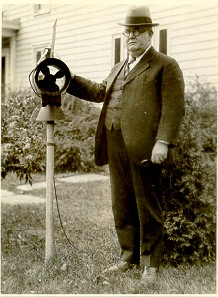
When Thomas J. Headlee retired in 1944 the Headlee Fellowship was established as a tribute to him and to his firm conviction that applied research lags because of the lack of fundamental knowledge of insect physiology. The permanent fellowship is so established that interest income will provide support for the Fellowships. Contributions to the Fellowship Fund have come from students and associates of Dr. Headlee, but industrial concerns that benefited from Dr. Headlee's work provided the initial fund capital. Dr. Headlee's stated opinion was that "The key to optimum control of harmful insects lies in basic knowledge of how insecticides kill." Subsequent experiences in insect pest management work have borne out of the truth of this statement.
Candidates for the Headlee Fellowships are evaluated by the departmental Graduate Student Committee, which recommends awardees to the Headlee Board of Trustees. Two types of Headlee Fellowships are available, one is called Headlee-1 and entails support for a student just entering the Graduate Program in Entomology and the other, called Headlee-2, can support a student in their final year. Headlee-1 is renewable annually for a maximum of four years contingent on performance. Headlee-2 is not renewable.
The research program of the Fellowship was centered around the fundamentals of insect physiology and biochemistry but is now open to all aspects of insect biology investigations. Since the program was inaugurated in the fall of 1946, many Headlee Fellowships have been awarded. A list of some of the publications/dissertations supported by a Headlee Fellowship follows:
- 2001: Chansak Suwanchaichinda, Characterization and identification of cytochrome P450 monooxygenases involved in insecticide detoxification in Aedes albopictus mosquito larvae.
- 2000–2001: Zuzana Swiganova, Phylogeny and history of host-plant association in the leaf beetle genus Trirhabda Le Conte (Coleoptera: Chrysomelidae: Galerucinae).
- 1998: Wanmin Xin (na)
- 1996–1997: Peter Bosak, Habitat preference of host-seeking Coquillettidia perturbans (Walker) in relation to birds and eastern equine encephalomyelitis virus in New Jersey.
- 1995–1996: Yi Wang, Host-parasite interactions between entomopathogenic nematodes and Popillia japonicus (Coleoptera: Scarabaeidae) larvae.
- 1995: Shirley Luckhart, Suppression of cellular encapsulation in Heliothis virescens (f.) parasitized by Campoletis sonorensis (Cameron): Genetic and temporal partitioning by the wasp and its symbiotic polydnavirus.
- 1994: Liwang Cui, (transfer to Kentucky)
- 1993: Eric Solon, Signal transduction during exocytosis in Limulus granulocytes.
- 1992: Glen Holbrook, (transfer to NC)
- 1989–1990: Ann-Shyn Chiang, Developmental regulation of juvenile hormone biosynthesis in female cockroaches.
- 1984–1988: Alan Smith, Endogenous and exogenous factors regulating pheromone production and release in the adult female brown-banded cockroach.
- 1979–1983: Kenneth J. Medeiros, (transferred to Toxicology) Microsomal mixed function oxidases of resistant and susceptible Colorado potato beetle, Leptinotarsa decemlineata (Say).
- 1970: Herbert Bolton, Toxicology and genetics of reduced permeability of house fly cuticle to insecticides.
- 1970: Alan Tomlin, The toxicity, penetration and metabolism of "Gardona" in gypsy moth larvae.
- 1956: Fred C. Swift, A manometric assay for DDT-Dehydrochlorinase and its application to the investigation of the in vitro metabolism of DDT, TDE, and methoxychor by the Mexican bean beetle and resistant house fly.
- 1956: Thomas M. Stevens, The occurrence of hyaluronidiases in insects and considerations of their role in Periplaneta americana.
- 1948: Andrew J. Forgash, Some physiological and biochemical effects of arsenic triokite on the American cockroach, Periplaneta americana, with special reference to reduced glutathione.
- 1948: George T. Fisher, The effect of various insecticides on the cytochrome oxidase system of the American roach Periplaneta americana.
- 1948: Donald G. Cochran, A study of the distribution and metabolism of DDT in the tissues of the American cockroach, Periplaneta american, with special reference to sex and developmental differences.
- 1946: John P. Reed, Mites of the Genus Tarsonemus occurring on tomatoes in New Jersey.


